ASUS Maximus VII Impact Review: Premium Gaming Z97 in mini-ITX
by Ian Cutress on December 9, 2014 10:00 AM ESTCPU Performance
Readers of our motherboard review section will have noted the trend in modern motherboards to implement a form of MultiCore Enhancement / Acceleration / Turbo (read our report here) on their motherboards. This does several things, including better benchmark results at stock settings (not entirely needed if overclocking is an end-user goal) at the expense of heat and temperature. It also gives in essence an automatic overclock which may be against what the user wants. Our testing methodology is ‘out-of-the-box’, with the latest public BIOS installed and XMP enabled, and thus subject to the whims of this feature. It is ultimately up to the motherboard manufacturer to take this risk – and manufacturers taking risks in the setup is something they do on every product (think C-state settings, USB priority, DPC Latency / monitoring priority, memory subtimings at JEDEC). Processor speed change is part of that risk, and ultimately if no overclocking is planned, some motherboards will affect how fast that shiny new processor goes and can be an important factor in the system build.
Point Calculations – 3D Movement Algorithm Test: link
3DPM is a self-penned benchmark, taking basic 3D movement algorithms used in Brownian Motion simulations and testing them for speed. High floating point performance, MHz and IPC wins in the single thread version, whereas the multithread version has to handle the threads and loves more cores.
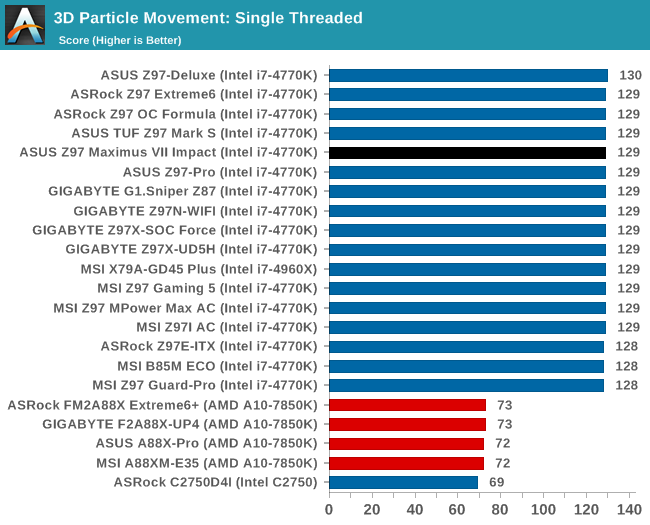
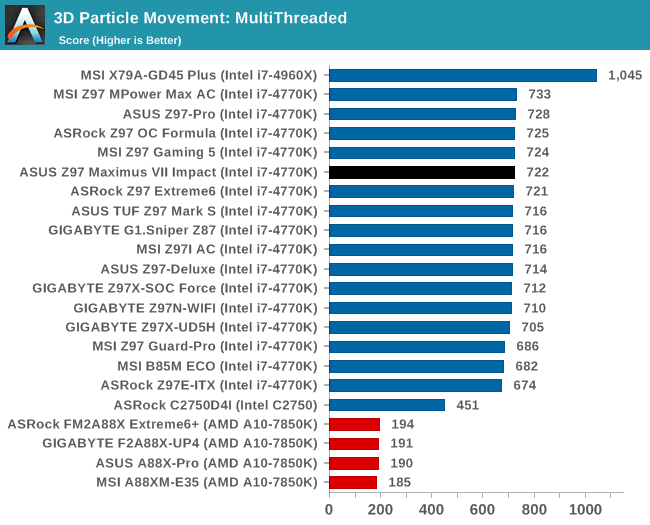
Compression – WinRAR 5.0.1: link
Our WinRAR test from 2013 is updated to the latest version of WinRAR at the start of 2014. We compress a set of 2867 files across 320 folders totaling 1.52 GB in size – 95% of these files are small typical website files, and the rest (90% of the size) are small 30 second 720p videos.
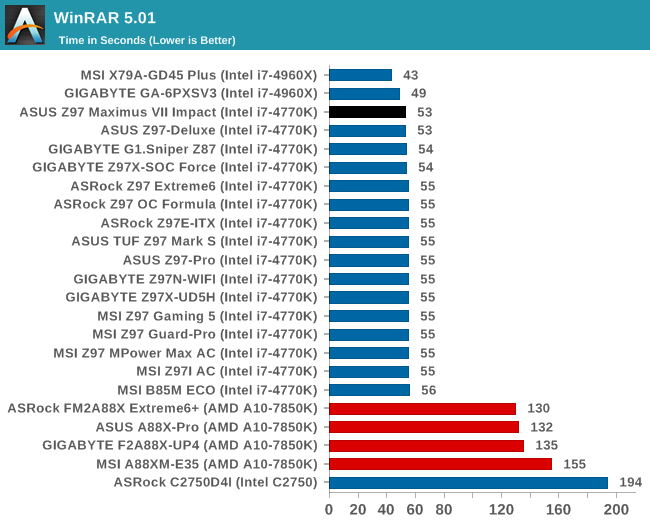
Image Manipulation – FastStone Image Viewer 4.9: link
Similarly to WinRAR, the FastStone test us updated for 2014 to the latest version. FastStone is the program I use to perform quick or bulk actions on images, such as resizing, adjusting for color and cropping. In our test we take a series of 170 images in various sizes and formats and convert them all into 640x480 .gif files, maintaining the aspect ratio. FastStone does not use multithreading for this test, and thus single threaded performance is often the winner.
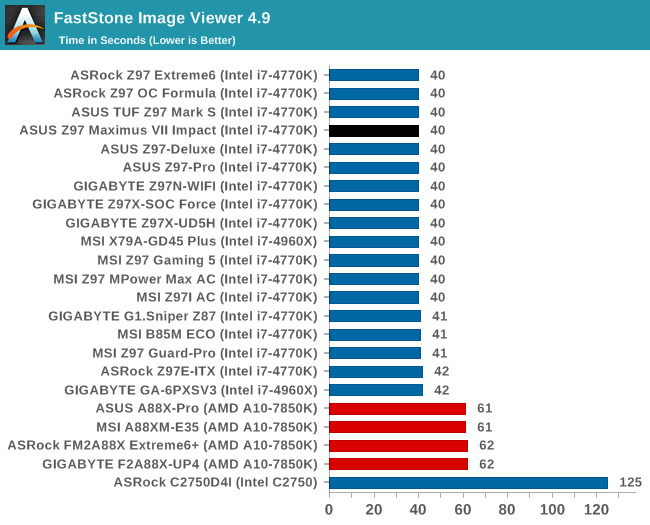
Video Conversion – Handbrake v0.9.9: link
Handbrake is a media conversion tool that was initially designed to help DVD ISOs and Video CDs into more common video formats. The principle today is still the same, primarily as an output for H.264 + AAC/MP3 audio within an MKV container. In our test we use the same videos as in the Xilisoft test, and results are given in frames per second.
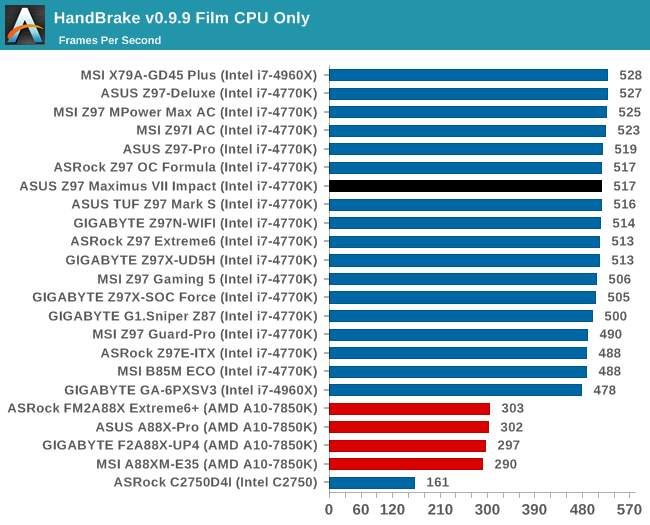
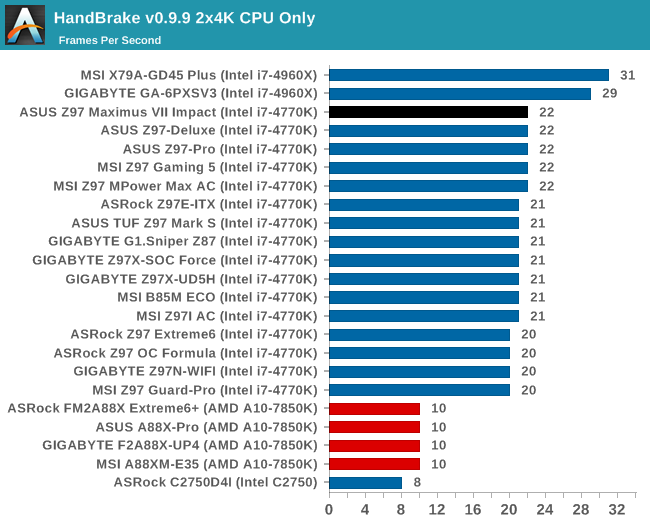
Rendering – PovRay 3.7: link
The Persistence of Vision RayTracer, or PovRay, is a freeware package for as the name suggests, ray tracing. It is a pure renderer, rather than modeling software, but the latest beta version contains a handy benchmark for stressing all processing threads on a platform. We have been using this test in motherboard reviews to test memory stability at various CPU speeds to good effect – if it passes the test, the IMC in the CPU is stable for a given CPU speed. As a CPU test, it runs for approximately 2-3 minutes on high end platforms.
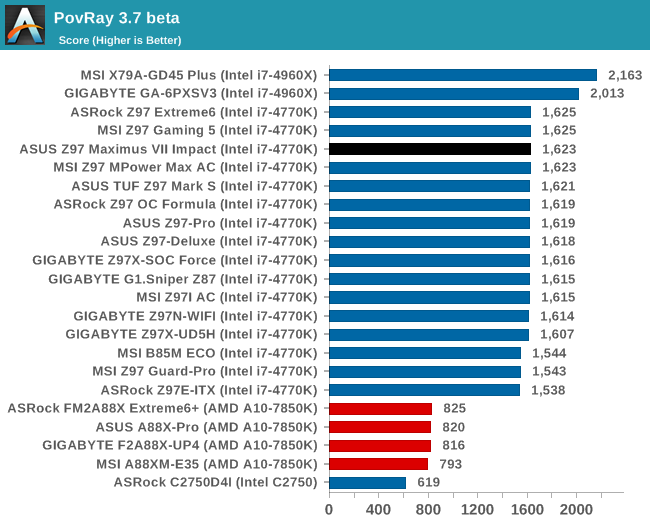
Synthetic – 7-Zip 9.2: link
As an open source compression tool, 7-Zip is a popular tool for making sets of files easier to handle and transfer. The software offers up its own benchmark, to which we report the result.
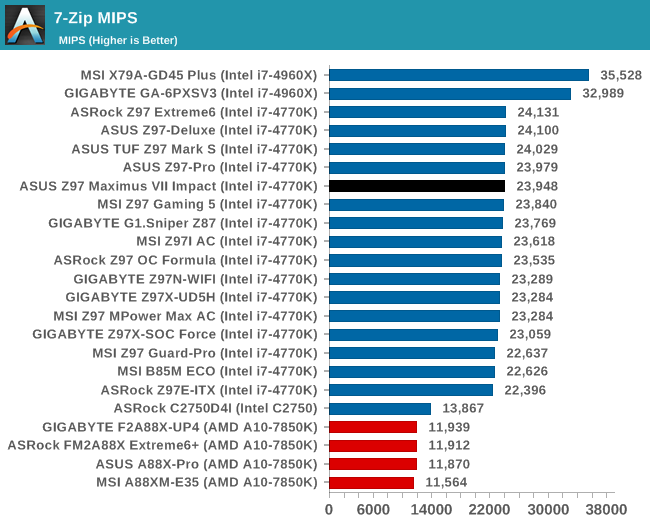










41 Comments
View All Comments
mooninite - Thursday, December 11, 2014 - link
The stock Intel cooler was what I originally had with my Impact and 4790k. Running an ffmpeg, h264 encode would reach 100C (the thermal limit) and throttle within a few minutes. I then purchased a ZALMAN CNPS8900 Extreme. This allowed ffmpeg to run while staying just under the 100C limit. After further reading of the Intel forum, with Intel support representatives replying, the motherboards are syncing all ratios, and a proper 44/44/43/42 ratio setting dropped temps even further to below 80C.Undervolting is next to impossible on stock clocks. I have my adaptive voltage set to -0.05v. Anything more and the system is not stable.
WithoutWeakness - Wednesday, December 10, 2014 - link
I think ASUS assumes that if you're spending $200+ on one of their ROG-branded motherboards and $200-$300+ on a K-series unlocked processor then you're also probably spending $50+ on a CPU cooler that is good enough to cope with the additional heat of a few hundred MHz overclock and the potential corresponding voltage bump that comes with it.It might be an unfair assumption to expect all users to buy a separate CPU cooler but they're targeting a certain audience with their ROG hardware and know that most of those users won't just rely on the stock heatsink/fan to keep their CPU adequately cooled.
takeshi7 - Tuesday, December 9, 2014 - link
I don't understand why manufacturers don't include 5.1 analog audio on high end ITX boards. If I can't have a sound card I'd at least like to have nice integrated audio.xenol - Tuesday, December 9, 2014 - link
Many of them do have the full set of 5.1 with mic and line-in. I'm sure this board just multiplexes the ports.nathanddrews - Tuesday, December 9, 2014 - link
My guess is that if you care that much about high quality audio, you would want to pass through to an external receiver/DAC/amplifier. From my experience onboard DAC always results in audible feedback. Digital out to an AVR resolves it.bigboxes - Tuesday, December 9, 2014 - link
He said nice, not high end. I have great sounding audio. Granted it's not on-board. Rather it's a Soundblaster X-Fi card paired with some Swans. If you are that anal about audio then you are going to do as you prescribed. However, we all don't want receiver/DAC/amps on our desktops. Don't blame you if you do though just don't poo-pah the OP for making the suggestion.bigboxes - Tuesday, December 9, 2014 - link
With such a small board there is no place for a external DAC add in card, hence your comment. I wasn't thinking about that.Pork@III - Tuesday, December 9, 2014 - link
The parameters and component of test system are unreal experiment with board which mainly to relevant for HTPC.ExarKun333 - Tuesday, December 9, 2014 - link
I like the error LED on the back plate. Very handy for a cramped build.Laststop311 - Tuesday, December 9, 2014 - link
This is without a doubt the very best mini itx board on the market period. If I was going to build a mini itx system this is the board I would get. And for being the very best available the price isn't all that bad.